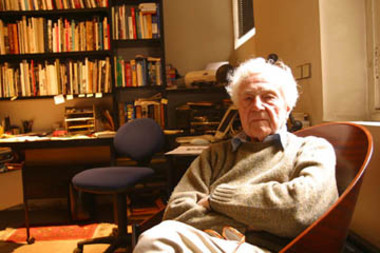The story of D-Day told through pictures
June 6, 2004 - The Houston Chronicle

PARIS—His life story reads like a bird’s-eye view of the last half-century.
Photo editor John Morris partied with Ernest Hemingway, directed Alfred Hitchcock, worked with John Steinbeck and helped one of the best-known photo agencies in the world get off the ground.
But topping his list of accomplishments, perhaps, was his work 60 years ago as London picture editor for Life magazine, where he helped transform 11 grainy photos of Normandy’s Omaha Beach into the defining images of D-Day.
The pictures taken by Robert Capa, once known as the “greatest war photographer in the world,” were used years later as models for the opening scene of director Steven Spielberg’s 1998 movie Saving Private Ryan.
“Their very crudeness gives a feeling of the struggle itself,” says the American-born Morris, now a spry 87, during an interview at his Paris apartment.
“We’d been waiting for this moment for so long,” he says of the landing of Allied troops on Normandy’s beaches on June 6, 1944. “The photos are symbols of the final offensive.”
The 11 photos were the only frames on the four rolls of 35-millimeter film Capa sent to London from the front that could be salvaged. When asked about the story of the destroyed photos, Morris lets out a quick sigh and says, “That was me.”
Technically, it was a hurried photo developer working for Morris who ruined the pictures, but Morris takes the blame. In the rush to get the photos back to the United States, the technician accidentally melted the emulsion off most of the film.
Getting the photos that remained to the United States for publication was no easy task. Morris grabbed the pictures, dove into his car and raced the photos to the censor’s bureau.
After an agonizing wait to get them cleared, he sped down side streets before abandoning his car and sprinting across Grosvenor Square to meet a courier who would have left with or without the photos a minute later.
The photos appeared in the June 19, 1944, issue of Life and later became synonymous with D-Day. Despite the loss of Capa’s other pictures, Life’s editors cabled Morris to thank him, saying, “Today was one of the great picture days in Life’s office.”
Morris himself arrived on Utah Beach on July 16 while the battle for Normandy was still on and stayed there for four weeks.
“There’s nothing quite like it,” he says of being on the front, compared with simply seeing photos taken there. “You feel the war in your stomach.”
During his stay on the front, Morris was shot at several times and forced into a last-minute change of plans that kept him from being bombed in a friendly-fire disaster at Saint-Lo. Dust from a wave of Allied bombings had kept pilots in the second wave from seeing they were dropping bombs on the Americans whom Morris was to visit.
“I was lucky,” he says. “I was glad to have the experience (of going to Normandy) but happier to escape.”
After his London posting with Life, Morris became picture editor for the Ladies’ Home Journal and the first executive editor of Magnum Photos. He later became picture editor for the Washington Post and the New York Times before being named the Paris correspondent for National Geographic.
Morris, who penned a 1998 autobiography, Get the Picture: A Personal History of Photojournalism, once directed Hitchcock in a photo shoot for Life and attended a London party with Hemingway. While working for the Ladies’ Home Journal, he assigned a freelance piece to Steinbeck. Over time, Magnum became one of the most prestigious photo agencies in the world.
Today, Morris is as active as ever in Paris, organizing left-leaning political rallies, writing newspaper articles for English-language newspapers and working with a small French publisher to put together a new book on Capa’s D-Day photos.
He compares war photo censorship today with that of 60 years ago. “During World War II, I would receive photos of stacks and stacks of bodies in Berlin,” he says. “I would take them to the censors who said, `You can have these back after the war.’
“The current torture pictures would never have got out,” he says, referring to photos taken of Iraqi inmates at Baghdad’s Abu Ghraib prison.
In October 2001, Morris wrote in a new afterword in his autobiography that photojournalism was being reborn and moving away from profitable entertainment-based “news” because of the terrorist attacks in the United States. Now, though somewhat more skeptical, he says he is encouraged by the media’s handling of events in Iraq.
“We’re beginning to see pictures of both sides of the story,” Morris says. “The public is beginning to see the light.”
And if he were editing for Life now?
“I’d try to show (Iraq) in its bloody reality. ... I would have run the (casket) pictures,” he says, referring to the controversial U.S. government ban on running photos of soldiers killed in Iraq.
Morris included two photos of Capa’s casket in Get the Picture after the photographer was killed in 1954 while covering the French war in Indochina.
Looking back at D-Day, Morris says simply: “It amazes one.”
He has provided viewers a look at almost all of the great world conflicts of his time.
But World War II, Morris says, was “the one war of my lifetime I could believe in.”